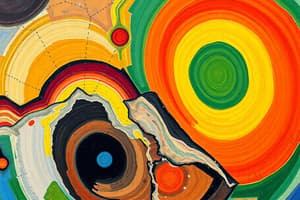Podcast
Questions and Answers
The study of earthquakes is known as ______.
The study of earthquakes is known as ______.
seismology
The instrument used to detect and record ground motion is called a ______.
The instrument used to detect and record ground motion is called a ______.
seismograph
The graphical output produced by a seismograph is referred to as a ______.
The graphical output produced by a seismograph is referred to as a ______.
seismogram
A series of tremors that occur before the main earthquake are known as ______.
A series of tremors that occur before the main earthquake are known as ______.
Aftershocks are ______ earthquakes that follow the main shocks.
Aftershocks are ______ earthquakes that follow the main shocks.
Flashcards are hidden until you start studying
Study Notes
Seismology
- The study of earthquakes and related phenomena.
### Seismologists
- Scientists who specialize in studying earthquakes and their effects.
Seismograph
- A device that detects and records ground motion during an earthquake.
Seismograms
- The visual records produced by seismographs, showing the intensity and duration of seismic waves.
Magnitude
- A measurement of the energy released by an earthquake at its source (hypocenter).
Richter Scale
- A logarithmic scale, developed by Charles Richter in 1935, to measure earthquake magnitude.
### Foreshocks
- Smaller tremors that often precede a major earthquake.
### Aftershocks
- Smaller earthquakes that follow a major earthquake and can cause further damage.
### Earthquake Hazards
- Ground shaking: The vibration of the ground during an earthquake, causing structural damage.
- Ground rupture: The visible cracking and displacement of the Earth's surface during an earthquake.
### Before Earthquakes
- Familiarization with local earthquake risks is essential for preparedness.
### During Earthquakes
- Cover - Hold on - Drop: This safety protocol minimizes injury during an earthquake.
### After Earthquakes
- Evacuation: Seek safe exit routes as soon as the shaking stops.
- Aftershock awareness: Be prepared for additional tremors that may occur after the main shock.
- Injury check: Assess for injuries in yourself and others.
### During Earthquakes (Safety Measures)
- Find open spaces if outdoors to avoid falling debris.
- Move to higher ground if near the coast to avoid tsunamis.
- Stay away from steep slopes that may be susceptible to landslides.
- Stop moving vehicles safely if caught in a moving vehicle.
### After Earthquakes (Safety Measures)
- Avoid traversing bridges or overpasses as they may be damaged.
Studying That Suits You
Use AI to generate personalized quizzes and flashcards to suit your learning preferences.




